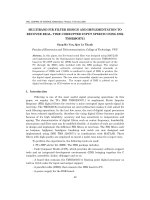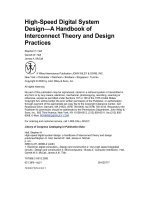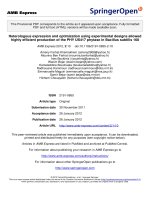High speed fir filter design and optimization using artificial intelligence techniques
Bạn đang xem bản rút gọn của tài liệu. Xem và tải ngay bản đầy đủ của tài liệu tại đây (915.46 KB, 177 trang )
HIGH-SPEED FIR FILTER
DESIGN AND OPTIMIZATION USING ARTIFICIAL
INTELLIGENCE TECHNIQUES
CEN LING
(B. Eng., USTC; M. Eng., IMPCAS)
A THESIS SUBMITTED
FOR THE DEGREE OF DOCTOR OF PHILOSOPHY
DEPARTMENT OF ELECTRICAL AND COMPUTER ENGINEERING
NATIONAL UNIVERSITY OF SINGAPORE
2005
i
Acknowledgements
I would like to express my most sincere appreciation to my supervisor Dr. Lian Yong for
his guidance, patience and encouragement throughout the period of my research. His
stimulating advice benefits me in overcoming obstacle on my research path.
My earnest gratitude also goes to Professor Yong Ching Lim and Dr Sadasivan
Puthusserypady for their valuable advices.
Most importantly, I wish to thank my parents, Cen Shi and Fan Huilan, for their love and
support and for all things they have done for me in my life and thank my bothers, Cen
Lei and Cen Weidong, my sister Cen Wei for their care, encouragement and love. I also
would like to thank my husband, Liu Ming for his encouragement and accompanying
during the period. Special thanks to my son Liu Cenru for the happiness he has given to
me.
I am also grateful to all friends in Signal Processing and VLSI Design Lab in the
Department of Electrical and Computer Engineering for making my years in NUS a
happy time. They are Mr. Francis Boey, Dr. Yu Yajun, Mr. Liu Xiaoyun, Dr. Yang
Chunzhu, Mr. Yu Jianghong, Ms. Cui Jiqing, Mr. Luo Zhenyin, Mr. Zhou, Xiangdong,
Mr. Liang Yunfeng, Ms. Zheng Huanqun, Ms. Sun Pinping, Mr. Wang Xiaofeng, Mr.
ii
Lee Jun Wei,, Mr. Yu Rui, Ms. Hu Yingping, Mr. Cao Rui, Mr. Gu Jun, Mr. Wu Honglei,
Mr. Tong Yan, Mr. Chen Jianzhong and Mr. Pu Yu.
Finally, I wish to acknowledge National University of Singapore (NUS) for the financial
support provided throughout my research work.
iii
Contents
ACKNOWLEDGEMENTS I
CONTENTS III
SUMMARY VII
LIST OF FIGURES IX
LIST OF TABLES XII
GLOSSARY OF ABBREVIATIONS XV
LIST OF SYMBOLS XVII
INTRODUCTION 1 -
1.1 SIGNED POWERS-OF-TWO BASED FILTER DESIGN 2 -
1.2 RESEARCH OBJECTIVES AND MAJOR CONTRIBUTION OF THIS THESIS 8 -
1.3
ORGANIZATION OF THE THESIS - 12 -
1.4
LIST OF PUBLICATIONS - 15 -
DESIGN OF CASCADE FORM FIR FILTERS 17 -
2.1 INTRODUCTION - 17 -
2.2 A HIGH-SPEED FILTER STRUCTURE 21 -
iv
2.3 QUANTIZATION NOISE REDUCTION FOR CASCADED FIR FILTERS USING SIMULATED
ANNEALING 23 -
2.3.1 Simulated Annealing Algorithm 25 -
2.3.2 Minimization of Quantization Noise 26 -
2.4 GENETIC ALGORITHMS (GAS) 30 -
2.5 GA FOR THE DESIGN OF LOW POWER HIGH-SPEED FIR FILTERS 35 -
2.5.1 GA Implementation 35 -
2.5.2 Design Example 44 -
2.6 AN ADAPTIVE GENETIC ALGORITHM (AGA) 48 -
2.6.1 Adaptive Population Size 48 -
2.6.2 Adaptive Probabilities of Crossover and Mutation 50 -
2.7 AGA FOR THE DESIGN OF LOW POWER HIGH-SPEED FIR FILTERS WITH TRUNCATION
EFFECT - 51 -
2.7.1 AGA Implementation for Cascaded FIR Filter Design 53 -
2.7.2 Truncation Effect on the Cascaded Structure 54 -
2.7.3 Optimal Truncation Margin 56 -
2.7.4 Design Example 58 -
2.8 CONCLUSION 60 -
DESIGN OF FREQUENCY RESPONSE MASKING FILTER USING AN
OSCILLATION SEARCH GENETIC ALGORITHM 69 -
3.1
INTRODUCTION - 69 -
3.2
FREQUENCY-RESPONSE MASKING TECHNIQUE - 72 -
v
3.3 OSCILLATION SEARCH GENETIC ALGORITHM (OSGA) - 75 -
3.3.1 The Implementation of GA 76 -
3.3.2 Oscillation Search (OS) Algorithm 77 -
3.4 DESIGN EXAMPLE 81 -
3. 5 CONCLUSION 84 -
DESIGN OF MODIFIED FRM FILTERS USING THE GENETIC ALGORITHM
AND SIMULATED ANNEALING 90 -
4.1
INTRODUCTION - 90 -
4.2
A MODIFIED FRM STRUCTURE - 92 -
4.3 A HYBRID GENETIC ALGORITHM (GSA) - 93 -
4.4 GSA FOR THE DESIGN OF MODIFIED FRM FILTERS 98 -
4.5 DESIGN EXAMPLE 100 -
4.6 CONCLUSION 104 -
AN EFFICIENT HYBRID GENETIC ALGORITHM FOR THE OPTIMAL
DESIGN OF FIR FILTERS 109 -
5.1
INTRODUCTION - 109 -
5.2
A HYBRID GENETIC ALGORITHM (AGSTA) - 111 -
5.2.1 The Overview of AGSTA 112 -
5.2.2 Tabu-Check and Repair Mechanism 115 -
5.3 DESIGN EXAMPLE 119 -
5.4
CONCLUSION 125 -
vi
A MODIFIED MICRO-GENETIC ALGORITHM FOR THE DESIGN OF FIR
FILTERS 127 -
6.1 INTRODUCTION - 127 -
6.2 A MODIFIED MGA WITH VARYING PROBABILITIES OF CROSSOVER AND MUTATION
128 -
6.3 MGA FOR THE DESIGN OF DIGITAL FIR FILTERS WITH SPOT COEFFICIENTS 131 -
6.4 MGA FOR THE COMPLEXITY REDUCTION OF HIGH-SPEED FIR FILTERS - 132 -
6.5
A COMPARISON AMONG PROPOSED AGA, OSGA, GSA, AGSTA, AND MGA - 138 -
6.6
CONCLUSION 141 -
CONCLUSION 142 -
7.1 SUMMARY 142 -
7.2 FUTURE WORK - 145 -
BIBLIOGRAPHY 146 -
vii
Summary
Finite impulse response (FIR) digital filters are preferred in most of the wireless
communication systems and biomedical applications due to its linear phase properties. A
major drawback of the FIR filters is the large number of arithmetic operations needed for
its implementation, which limits the speed of the filter and requires high power. It is well
known that the coefficients of an FIR filter can be quantized into sum or difference of
signed powers-of-two (SPoT) values leading to a multiplication-free implementation. In
the application-specific integrated circuit (ASIC) implementation, a long FIR filter can
operate at high speed without pipelining if it is factorized into several short filters whose
coefficients are in the form of SPoT terms. Such implementation reduces the hardware
cost and lowers the power consumption significantly as it converts multiplication to a
small number of shift and add operations. However, the design of FIR filter with SPoT
coefficient values is a complex process requiring excessive computer resources,
especially in situations where several filters have to be jointly designed.
In this thesis, several optimization schemes based on the artificial intelligence techniques
are presented for the design of high-speed FIR filters with SPoT coefficient values.
Firstly, genetic algorithm (GA) based optimization methods are proposed for the design
of low power high-speed FIR digital filters. The high-speed and low power features are
achieved by factorizing a long filter into several cascaded subfilters each with SPoT
viii
coefficients. Significant savings on hardware cost are achieved due to the fact that the
information which is related to hardware requirement is affiliated to the fitness function
as an optimization criterion. An adaptive genetic algorithm (AGA) with varying
population size and probabilities of genetic operations is proposed to improve the
optimization performance of conventional GA. Secondly, two hybrid algorithms are
presented for the synthesis of very sharp linear phase FIR digital filters with SPoT
coefficients based on frequency response masking technique (FRM). They are generated
by combining the GA with an oscillation search (OS) algorithm and with the simulated
annealing (SA) algorithm, respectively. The OS and SA algorithms are used to improve
the convergence speed of the GA and prevent premature convergence. Thirdly, an
efficient algorithm is proposed for the design of general FIR filters with SPoT coefficient
values, where AGA, SA and tabu search (TS) techniques cooperate during the
optimization process. The proposed algorithm achieves not only the improvement of
solution quality but also the considerable reduction on computational efforts. Fourthly, a
modified micro-genetic algorithm (MGA) is applied to overcome the drawbacks of the
conventional GA of long computation time by utilizing a small population. To avoid
entrapment in local optimum, the MGA is modified to adjust the probabilities of
crossover and mutation during the evolutionary process. The proposed method can design
digital FIR filters with SPoT coefficient values in much higher speed than conventional
GA.
ix
List of Figures
Fig. 2. 1 Block diagrams of twicing and sharpening schemes 19 -
Fig. 2. 2 A cascade form filter consisting of p subfilters 23 -
Fig. 2. 3 The relationship between hardware cost and the number of subfilters. 39 -
Fig. 2. 4 The convergence results by using Generation-Replacement and Steady-State
Reproduction 43 -
Fig. 2. 5 The frequency responses of the two subfilters (a) and overall filter (b). 46 -
Fig. 2. 6 The frequency responses of the three subfilters (a) and overall filter (b). 47 -
Fig. 2. 7 The word lengths of the output signals in different forms of realization. 52 -
Fig. 2. 8 The frequency responses of the three subfilters (a) and overall filter (b). 61 -
Fig. 2. 9 The frequency responses of the two subfilters (a) and overall filter (b). 62 -
Fig. 2. 10 The frequency responses of the four subfilters (a) and overall filter (b) 63 -
Fig. 2. 11 The frequency responses of the five subfilters (a) and overall filter (b). 64 -
Fig. 2. 12 The frequency responses of the six subfilters (a) and overall filter (b) 65 -
Fig. 3. 1 A realization structure for FRM approach 73 -
Fig. 3. 2 The frequency responses of various subfilters in the FRM technique. 74 -
Fig. 3. 3 The frequency response of H
a
(z
6
) with the overall filter stopband attenuation of
40.21 dB 85 -
x
Fig. 3. 4 The frequency responses of H
Ma
(z) and H
Mc
(z) with the overall filter stopband
attenuation of 40.21 dB 85 -
Fig. 3. 5 The frequency response of the overall filter with the overall filter stopband
attenuation of 40.21 dB 86 -
Fig. 3. 6 The frequency response of H
a
(z
6
) with the overall filter stopband attenuation of
38.12 dB 86 -
Fig. 3. 7 The frequency responses of H
Ma
(z) and H
Mc
(z) with the overall filter stopband
attenuation of 38.12 dB 87 -
Fig. 3. 8 The frequency response of the overall filter with the overall filter stopband
attenuation of 38.12 dB 87 -
Fig. 4. 1 A realization structure for a modified frequency response masking approach 92
-
Fig. 4. 2 The convergence trends of the GA (a) and GSA (b) within the first 500
generations 97 -
Fig. 4. 3 The frequency responses of the three subfilters (a) and overall filter (b) of H
a
(z).
107 -
Fig. 4. 4 The frequency responses of H
Ma
(z) and H
Mc
(z). 107 -
Fig. 4. 5 The frequency response of the overall filter 108 -
Fig. 4. 6 The convergence trend of the GSA. 108 -
Fig. 5. 1 The flow chart of AGSTA 117 -
xi
Fig. 5. 2 The flow chart of TS implementation. 118 -
Fig. 5. 3 The frequency response of the filter with length of 23. 120 -
Fig. 5. 4 The frequency responses of the filters with lengths of 27, 28, 29, 31 and 33 122
-
Fig. 5. 5 The frequency responses of the filters with lengths of 31, 33, 35, 37, 39 and 41
- 123 -
Fig. 6. 1 The frequency response of the direct form filter designed by using MGA 132 -
Fig. 6. 2 The frequency responses of the two subfilters (a) and overall filter (b). 135 -
Fig. 6. 3 The frequency responses of the three subfilters (a) and overall filter (b). 136 -
Fig. 6. 4 The frequency responses of the four subfilters (a) and overall filter (b) 137 -
xii
List of Tables
Table 2. 1 List of filter coefficients in three-subfilter structure 45 -
Table 2. 2 A comparison of hardware cost among different designs 45 -
Table 2. 3 The specifications of three filters with short, medium and long lengths 57 -
Table 2. 4 A comparisons of truncation margin between simulation and computation
results 57 -
Table 2. 5 A comparison of hardware cost among different designs 66 -
Table 2. 6 A comparison of hardware cost between pre-truncation and post-truncation- 66
-
Table 2. 7 List of the coefficients of filters with 2 (a), 3 (b) and 4 (c), 5 (d) and 6 (e)
subfilters 67 -
Table 3. 1 List of filter coefficients of H
a
(z), H
Ma
(z) and H
Mc
(z) with the overall filter
stopband attenuation of 40.21 dB 88 -
Table 3. 2 A comparison among different designs from the method in [36], GA [13] and
OSGA. 88 -
Table 3. 3 List of filter coefficients of H
a
(z), H
Ma
(z) and H
Mc
(z) with the overall filter
stopband attenuation of 38.12 dB. 89 -
xiii
Table 4. 1 List of filter coefficients of H
a1
(z), H
a2
(z) and H
a3
(z) 104 -
Table 4. 2 List of filter coefficients of H
Ma
(z) and H
Mc
(z) 105 -
Table 4. 3 A comparison on the word lengths of subfilters designed by using different
methods 105 -
Table 4. 4 A comparison among the designs achieved by using different methods. No.
Gen is the required number of generations to achieve the final solutions 106 -
Table 4. 5 A comparison of the average performance between OSGA and GSA over ten
independent runs. Successful runs refer to those which converge to the desired
solutions while unsuccessful runs refer to the runs which cannot find desired
solutions 106 -
Table 5. 1 A comparison of hardware cost between the designs using AGSTA and
polynomial-time algorithm [8] 121 -
Table 5. 2 A comparison of normalized peak ripples (NPR) among different methods.
The word length (excluding sign bit) is 9. The designs from MILP [1] use fixed 2
SPoT terms for each coefficient. Total of SPoT terms is 2N for the designs from
polynomial algorithm [8], SA [10] and GA 123 -
Table 5. 3 A comparison of normalized peak ripples (NPR) among different methods.
The word length (excluding sign bit) is 9. The designs from MILP [1] use fixed 2
SPoT terms for each coefficient. Total of SPoT terms is 2N for the designs from
polynomial algorithm [8] and SA [10]. 124 -
xiv
Table 5. 4 A comparison between GA and AGSTA over 10 independent runs. Successful
runs refer to the runs where the best solutions can be found 125 -
Table 6. 1 A comparison between the filters designed by using GA and MGA 132 -
Table 6. 2 A comparison among the filters with 2, 3, and 4 subfilters designed by using
GA and MGA 138 -
Table 6. 3 A comparison among the designs from the GA, AGA, OSGA, GSA, AGSTA,
and MGA over 10 runs 140 -
xv
Glossary of Abbreviations
AGA: Adaptive genetic algorithm
AGSTA: A hybrid algorithm formed by integrating adaptive genetic algorithm, simulated
annealing and tabu search techniques
AI: Artificial intelligence
ASIC: Application-specific integrated circuit
CSA: Carry save adders
CSD: canonic signed-digit
DSP: Digital signal processing
FIR: Finite impulse response
FRM: Frequency-response masking
FPGA: Field Programmable Gate Array
GA: Genetic algorithm
GSA: A hybrid algorithm formed by integrating genetic algorithm and simulated
annealing algorithm
IIR: Infinite impulse response
ILP: Integer linear programming
MILP: Mixed-integer linear programming
MGA: Micro-genetic algorithm
xvi
NPR: Normalized peak ripples
OS: Oscillation search
OSGA: Oscillation search genetic algorithm
PRP: Proportional relation-preserve method
SA: Simulated annealing
SPoT: Signed powers-of-two
SSS: Simple symmetric-sharpening method
TS: Tabu search
VLSI: Very Large Scale Integration
xvii
List of Symbols
a
1
, a
2
and a
3
:
Positive weighting coefficients in fitness function
b: Search index in OS algorithm
B: Coefficient word length
B
j
: Coefficient word length of j
th
subfilter
df
T
: Temperature decreasing factor in SA algorithm
Diff: Difference between the absolute value of the maximal and minimal coefficients
E: Energy
∆E: Change of energy
f: Fitness of a chromosome
f
T
: Sum of the fitness values in the population
f
avgo
, f
avgn
: Mean of the best fitness values during a specific number of generations
f
besti
: Best fitness in i
th
generation.
f
max
: Best fitness of current population
f
avg
: Average fitness of current population
f’: Larger fitness value of the two chromosomes to be crossed
G: Number of generations
G
S
: Start point for calculating the adjustment of population size in AGA
G
OS
: Number of generations in the application condition of OS
xviii
G
sA
: Number of generations in the application condition of SA
g
qn
: Controllable quantization noise gain
h(i): i
th
coefficient of an FIR filter
h
org
(i): Initial value of i
th
coefficient
h
i
: Coefficients of i
th
subfilter
H(z): z-transform transfer function of a FIR filter
H(e
jω
): Frequency response of H(z)
H
i
(z): z-transform transfer function of the i
th
subfilter
H
d
(e
jω
): Frequency responses of the desired filter
H
ip
(z): z-transform transfer function from the input of the i
th
subfilter to the output of the
p
th
subfilter
H
in
(f): The frequency responses of the prototype filter
H
out
(f): The frequency responses of the transformed filter
H
a
(z): Bandedge shaping filter in FRM structure
H
ai
(z): i
th
cascaded subfilter of H
a
(z)
H
c
(z): Complementary filter of H
a
(z)
H
Ma
(z), H
Mc
(z): A pair of masking filters in FRM structure
k
1
, k
2
, k
3
and k
4
: Positive weighting coefficients to control the adjustment of mutation
probabilities in AGA
k(ω): Positive weight in each band
L
end
: Convergence condition of SA
L
it
: Number of reordering iterations in pre-SA process
xix
M: Interpolation factor
N: Overall filter length
N
i
: Length of i
th
subfilter
N
a
: Length of H
a
(z)
N
ai
: Length of H
ai
(z)
N
T
: Total length of all subfilters
N
sub
: Sum of the lengths of partial subfilters
O: Objective function
O
OS
: Objective function in OS
P: Population size
P
org
: Original population size
P∆
: Adjustment of population size
p: Number of cascaded subfilters
p
c
: Crossover probability
p
m
: Mutation probability
p
a
: Adaptive acceptance probability in TS
p
os
: Application probability of OS
Q, R: Integers denoting the power of two
s(i): Ternary digit from {-1,0,1}
S: SPoT number represented to a precision 2
Q
by L - Q ternary digits s(i)
S
T
: Total number of the SPoT terms
S
S
: Pre-specified maximal number of SPoT terms
xx
T: Temperature
T
end
: Ending temperature
Trig(n,ω): Trigonometric function
TM
j
: Truncation margin of j
th
cascaded subfilter
X(e
j
ω
): Frequency response of input signal
Y(e
j
ω
): Frequency response of output signal
Z
T
: Total number of zero-coefficients
ω
p
: Passband edge
ω
s
: Stopband edge
θ
: Passband edge of H
a
(z)
φ
: Stopband edge of H
a
(z)
Chapter 1 Introduction
- 1 -
Chapter 1
Introduction
Digital signal processing (DSP) techniques have been increasingly applied in most
engineering and science fields due to the explosive development in digital computer
technology and software development. Digital filters are basic building blocks for DSP
systems. There are two types of filters: finite impulse response (FIR) filters and infinite
impulse response (IIR) filters. Since FIR filters possess many desirable features such as
exact linear phase property, guaranteed stability, free of limit cycle oscillations, and low
coefficient sensitivity [64-66], they are preferred in most of the wireless communication
systems and biomedical applications. However, the order of an FIR filter is generally
higher than that of a corresponding IIR filter meeting the same magnitude response
specifications. Thus, FIR filters require considerably more arithmetic operations and
hardware components - delay, adder and multiplier. This makes the implementation of
FIR filters, especially in applications demanding narrow transition bands, very costly.
When implemented in VLSI (Very Large Scale Integration) technology, the coefficient
multiplier is the most complex and the slowest component. The large number of
arithmetic operations in the implementation also increases the power consumption. In the
modern applications, such as military devices, wearable devices and portable mobile
Chapter 1 Introduction
- 2 -
communication devices, the portability and low power dissipation play a very important
role.
To address the problem, considerable attention and efforts have been made on reducing
the complexities and power consumptions for the DSP systems. The cost of
implementation of an FIR filter can be reduced by decreasing the complexity of the
coefficients [1, 4-5, and 67]. Coefficient complexity reduction includes reducing the
coefficient word length and representing coefficients in effective form. One of the most
efficient ways is to design filters with coefficients restricted to the sum or difference of
signed powers-of-two values [1]. This leads to a so-called multiplication-free
implementation, i.e. the filter’s coefficient multipliers can be replaced by simple shift-and-
add circuits. Thus, the implementation complexity can be reduced, resulting in significant
increase in the speed and reduction in power dissipation.
1.1 Signed Powers-of-Two Based Filter Design
To design FIR digital filters over the signed powers-of-two (SPoT) discrete space was
firstly proposed by Lim and Constantinides [68]. Extensive research has shown that the
complexity of an FIR digital filter can be reduced by quantizing its coefficients into SPoT
values. This converts multiplication to simple operations of shift and add. Relatively
small chip area is required in VLSI realization, resulting in low cost, high speed, and high
yield. This section briefly describes the SPoT number characteristics and existing
optimization techniques for the design of digital filters subject to SPoT coefficients.
Chapter 1 Introduction
- 3 -
A number, S, is called an SPoT number in this thesis, if it is represented to a precision 2
Q
by R - Q ternary digits s(i) according to
{}
1
()2, () -1,0,1, 1,
R
i
iQ
Ssisi QiR
−
=
=∈≤≤−
∑
(1.1)
where R and Q are integers. Each nonzero digit term, s(i)
≠
0, is counted as a SPoT term.
The word length of S is (R-Q) bits. S is discrete values in increments of 2
Q
in the range
22 22,
RQ RQ
S−+ ≤≤ −
(1.2)
in which there are
1
21
RQ−+
− distinct values.
Preliminary studies have showed that only a limited number of SPoT terms are required
to meet a respectable set of specifications if a good optimization technique exists. Hence,
to represent the coefficients of a filter in this way, the coefficient multipliers can be
replaced by a small number of add/subtract-shift operations. The hardware complexity as
well as power consumption is thus largely reduced.
During the last three decades, there has been significant research interest in the design of
digital filters with discrete coefficients [1, 3-14, 69-74]. In [3] Munson has proposed a
method to obtain discrete coefficients by simply rounding the real valued coefficients of
the desired filter, which provides an optimal solution in the time domain error norm or in
the output minimal mean-square error norm sense. Considering the optimal design
solution in the frequency domain, Kodek [4] has introduced integer linear programming
(ILP) to solve the filter design problem. However, relatively long coefficient word length
and exponentially increased computer time with respect to the filter length make ILP
only suitable for the design of low-order FIR filters. To improve the performance of ILP
for designing high-order FIR filters with discrete coefficients, a mixed-integer linear
Chapter 1 Introduction
- 4 -
programming (MILP) technique has been proposed by Kodek. Although optimal design
in the minimax sense can be found using MILP, the application of this technique is
limited by high computing cost. Considerable efforts for the improvement of MILP have
been made to reduce its computational complexity for high-order FIR filter design in [4].
In [1], Lim and Parker proposed an improved MILP method for the design of FIR filters
with SPoT coefficient values. It is reported that their method can be efficiently used in
the design of filters with lengths up to 70 [5]. However, this is not long enough for some
designs, e.g. a filter with very sharp transition band. It is shown in [69] that MILP can
minimize the total number of SPoT terms if the problem is appropriately formulated, thus
leading to a filter with minimal implementation cost. However, MILP requires excessive
computing resources if the filter length is long. The computational cost required increases
exponentially with the number of variables to be optimized.
In [6], Zhao and Tadokoro proposed a suboptimal design for powers-of-two coefficient
based FIR filters. This algorithm is composed of two methods. The first is a suboptimal
design which preserves a proportional relation between the conventional FIR filters and
the powers-of-two coefficient based FIR filters, referred to as the proportional relation-
preserve method (PRP). The second is the application of the simple symmetric-
sharpening method (SSS) which is applied when the PRP method cannot realize the
given filter specifications. It is shown in [6] that with the help of the PRP and SSS
methods, FIR filters with lengths greater than 200 can be efficiently designed with
powers-of-two coefficient values, which addresses the very high computational cost of
the MILP.









